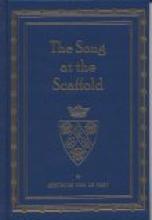No name
The Sinking of the Bismarck
Back in print! It was May 1941 and the British were struggling to hold back the Germans (this is of course before the United States had entered World War II). Since the summer of 1940 the Germans had access to the harbors and airfields of western Europe from Norway to southern France. Their submarines, warships and bombers were wreaking havoc on Britain's supply convoys crossing the Atlantic which was seriously threatening Britain's survival. It was at this time that the British admiralty learned of the imminent release of the new German battleship Bismarck, the most powerful warship afloat in the world. This is the story of the week-long chase by the British who were hoping to prevent further losses to their precious convoys by destroying the battleship. This very accurate account is more exciting and suspenseful than fiction partially because we realize how much is at stake. It is such a game of nerves and logic, but the interesting tales of "luck" and unbelievable human error might make the reader wonder (okay, it made me wonder) whether Divine Providence had a direct hand in the final outcome. Most appropriate for mid-gradeschool through high school (and plenty interesting for adults too!). It's suspenseful, but not too scary or graphic to be read aloud in front of younger siblings.
NOTE (12/3/07): This has recently come back into print as part of the Sterling Point series under the title The Sinking of the Bismarck: The Deadly Hunt.
The Small War of Sergeant Donkey
One day an American Serviceman is injured by a small troup of German soldiers and stranded on the mountain. Chico decides he wants to help, but the dangers are great. It wouldn't be fair to spoil the details of the adventure that follows, but I'll just say that the whole story is a wonderful one for children in many ways. American children tend to study very little of Italy during World War II. The historical details are fascinating here and especially appropriate as seen through the eyes of a child who has experienced war first hand. The simple details of the struggles of family life in Italy and the companionship they find with the homesick American soldiers are very nice. The simple, honest virtues of courage and friendship are embodied by the characters in the story. Finally, some of the Christmas and other traditions of Catholic Italy are woven into the story as well.
The story is suitable for a family read-aloud and could be read independently by early to mid-gradeschoolers. Sure to become a family favorite. Along with Twenty and Ten and The Winged Watchman, this would make an excellent first-glimpse at World War II - one of the most significant and influential events of our recent history.
The Snowflake: Winter's Secret Beauty
Of course it is good to study the natural causes of things like snowflakes in order to understand and appreciate them better, and that is what this book is about; lots and lots of beautiful, amazing, magnified photographs of snowflakes (these are simply breathtaking) and an introduction to the science of understanding them.
The text can get fairly technical at times and is most appropriate for high schoolers and adults (although it could certainly be appreciated by younger children - especially as a read-aloud). However the pictures - the numerous full-color pictures - will be appreciated by everyone in the family.
The Song at the Scaffold
The story is quite valuable from an historical perspective - particularly as we view the French Revolution from a Catholic perspective. This book would be appropriate for high school (probably Junior or Senior year) and would be excellent for teens and parents to read together in order to discuss the many facets of the story.
The Song of Bernadette
black and white, 156 min
The Spear
There is a scene in which a woman commits adultery (the same woman who Jesus saves from stoning). While the issue is important and is handled well, their attraction for each other might be described in a too-sensual way for some teens.
The Squire and the Scroll
As in the journey of Ulysses, they encounter several trials along their quest, in their case, testing the purity of their senses. Will they survive the tests or succumb to the same fate as all the other knights? In the story, children will be challenged on many levels. Will they follow the example of the squire or the knight? Will they obey their parents and listen to the wisdom of God's word or will they succumb to the enticements of the world? Will they guard their purity or squander it? Will they receive as the squire hopes "the promise of a reward from God in return for faithfully guarding his heart?"
originally appeared in Heart and Mind Magazine, Summer 2005 - used with permission
The Story About Ping
This is a well-loved book in our family - particularly in the preschool set. The illustrations are beautiful, the story simple and meaningful and the lessons timeless.









